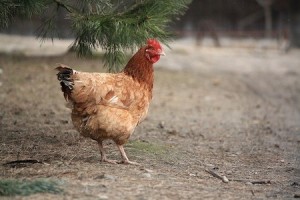How Old Are Your Chickens (and Why It Matters)?
 “Ugh, this is like eating a boiled tennis ball.” That was our first experience with eating one of our own chickens. It wasn’t Laura’s fault though; it had nothing to do with her cooking. She’s got excellent culinary skills.
“Ugh, this is like eating a boiled tennis ball.” That was our first experience with eating one of our own chickens. It wasn’t Laura’s fault though; it had nothing to do with her cooking. She’s got excellent culinary skills.
Over time we learned what was going on.
Books Smarts vs Experience
When we first began raising chickens years ago, we entered into it with as much knowledge as we could without having actually done it before.
Laura had read the Storey’s Guide to Raising Chickens and Carla Emory’s classicThe Encyclopedia of Country Living. Laura had learned all she could through these books and from the internet. Still there are some things you must learn through experience.
Processing a chicken is a good example. The first time I tried to process a chicken, I researched instructions. I found several ways from several different sources. I selected a method that looked the easiest and was well explained. Still, it took me almost an hour to process a single bird.
With years of experience behind me, now I can process 7 or 8 birds per hour. Some things you can read, understand, and know. But with other things, it takes hands-on experience to really learn it.
Producers or Consumers?
Over the years we’ve raised many different varieties of chickens. Some were great layers. Some were great meat birds. Some were a combination; they laid pretty well and were relatively meaty. It’s this last category, the combination birds, that we usually gravitate toward since they are dual purpose. (Some breeds make great setters, too. They go broody more often and take good care of their chicks. We like keeping some of those around as well to replenish our flock.)
After two or maybe three years, chickens produce far fewer eggs than they do when they are younger. In their prime, chickens lay one egg every 30 hours or so. During the summer months, when there is plenty of sunlight to help spur them on, you can expect to receive two eggs every three days from each chicken. Sometimes you’ll get even more from your overachievers. Others, won’t lay quite a often.
But as time goes on, their ability to lay diminishes. At that point, they become consumers rather than producers on the homestead.
Sure they still fertilize the fields with their chicken litter; they still help to break the parasite cycle by eating bugs and larva; and they still help spread piles of cow manure so it’s not overly concentrated in one small area.
But other chickens do all of that and supply us with a continual source of eggs.
As a rule everything we have contributes to the productivity of our little homestead. Some, like chickens, contribute in one way and then in another.
Don’t Roast Old Birds
“We have some chickens that are not laying eggs anymore. They are a few years old and probably need to go in the pot.”, Laura told me this past Friday night.
This is where experience helped us again. We learned from the boiled tennis ball incident years ago that not all birds are good for roasting.
Younger birds, say less than 1 year old or so, have good, tender meat. Your options with those birds are wide open. You can roast them in the oven, deep fry them southern-style, or bake them in a casserole. You can prepare them any way you’d like and they’ll be tender and taste good.
As a point of reference, the chickens you buy from supermarket are probably only 6 weeks old. Cornish Crosses are bred specifically to grow quickly and convert most of their caloric intake into meat. They grow so quickly and get so big, so fast, that they probably wouldn’t live much longer than 10 weeks anyway.
With older birds (not Cornish Crosses), on the other hand, you’re options are more limited. They get tough and chewy. The flavor is still good, but the texture makes for an unexpected workout for your jaw muscles. As I mentioned before, eating them can be like chewing a boiled tennis ball.
But that doesn’t mean you cannot use them.
When Life Gives You Old Chickens…
Make chicken soup.
Laura puts our older chickens in a pot and slow cooks them for several hours. Once they are well cooked and relatively tender, she pulls the meat from the bone in small pieces. She adds some veggies, such as carrots and celery, to turns them into delicious soup.
The process makes much more than we can eat at once sitting so Laura cans the soup in quart-sized jars. We store those jars away for those cold autumn or winter afternoons when a bowl of hearty soup would really hit the spot.
